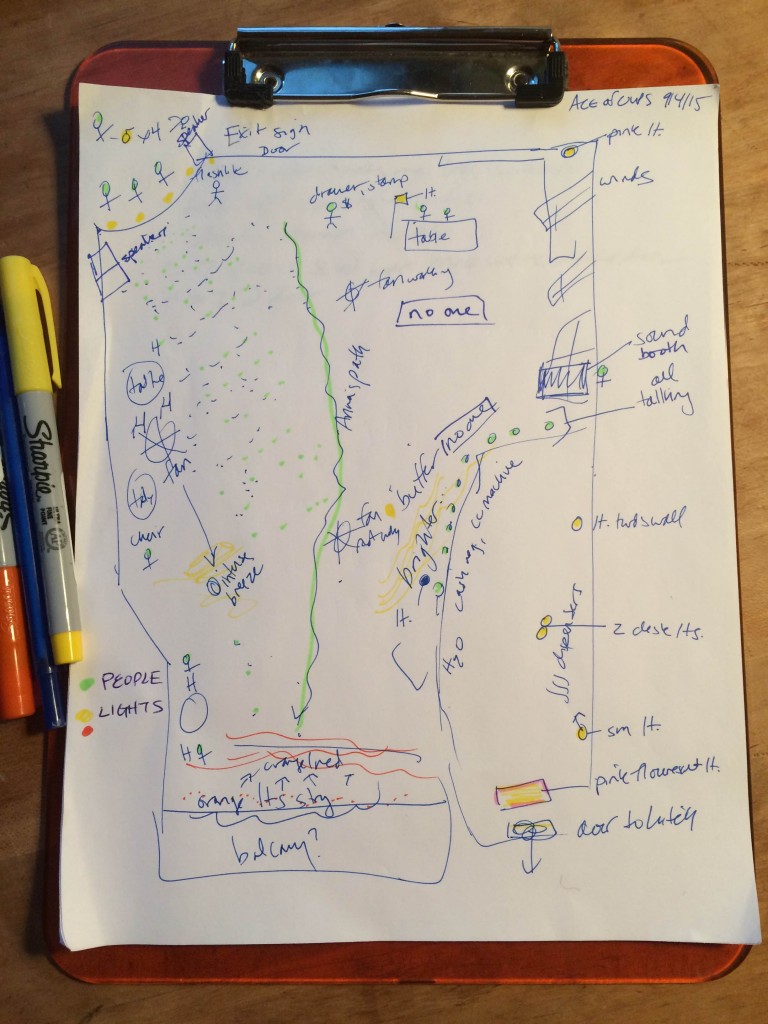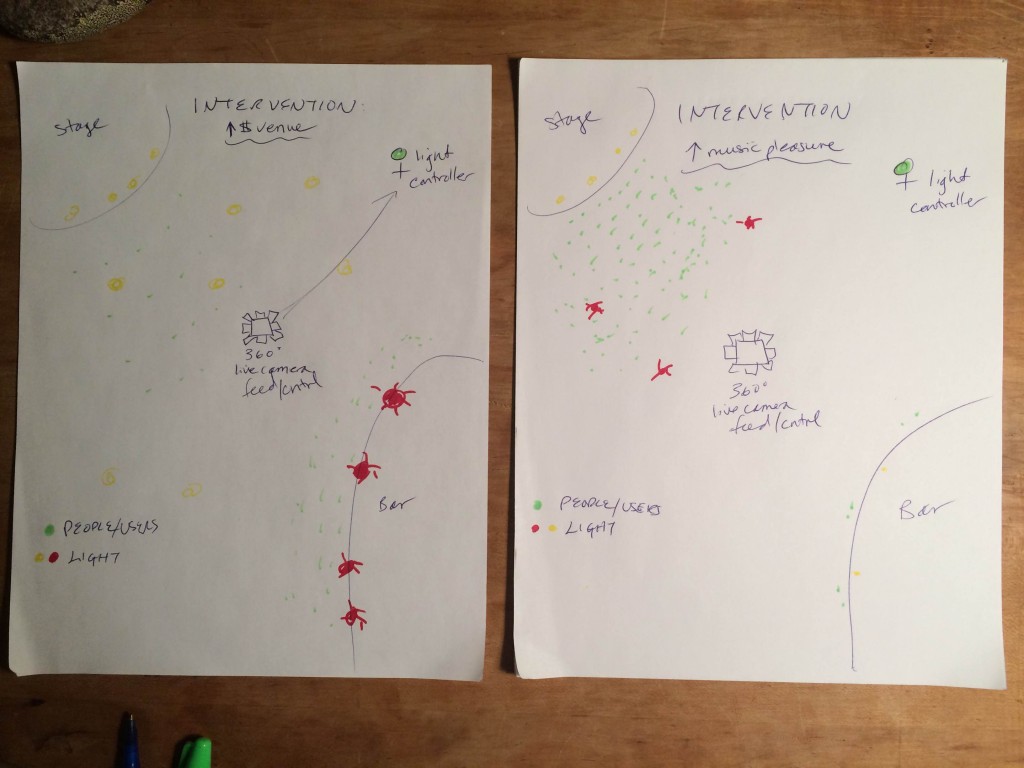Pressure Project I – Anna
Posted: September 5, 2015 Filed under: Anna Brown Massey, Pressure Project I 2 Comments »
Counterfeit Madison performs her Femme Fest set at Ace of Cups. Shot 09/04/15 at Femme Fest for Alive. (Meghan Ralston)
Showing up at a music venue on a holiday weekend with a clipboard and pen is a strong indication that you’re not only a graduate student, but you’re also a certified dweeb.
Putting that clipboard down, transfixed by Counterfeit Madison and her ability to set your feet deeply into the earth while landing you on the moon, is a strong indication that to be both wholly human and to devise experiential media systems (DEMS) you’ve got to fall headlong into the user-experience.
Devising EMSs requires analyzing existing media systems, which means approaching a local music show with an eye/ear/body-cognition towards scrutiny and (hypothetical) disruption. As a theater-maker, this is a familiar brain setting, but that night I practiced with some newly-attractive terms, like “present technology,” “user,” and “product.”
Public Place
2100 hours Friday 4th September
Ace of Cups, Femmefest
Columbus, Ohio
Users
Users: I am the user/audience member along with fellow ~200 payers-of-the-$7-cover.
Non-users / Purveyors of Product, in order of appearance:
- Bouncer
- Cashier
- Musicians
- Bartenders
- Barbacks
- Sound technician
- Merch seller
Products
Music and booze (also: social interaction, public space to smoke)
Existent Technology
- Electric Marquis
- Swinging Door
- Flashlight
- Drawer
- Overhead lights
- Standing lamps
- Wall lamps
- Fan overhead
- Air Conditioning (likely though undetected)
- Selected sound amplification: mics, speakers, control board
- Sound instruments: guitars, drumset, keyboard
Description of locomotive and stance choices by users:
ABM: As I enter the space, to my right forward diagonal stands a person who cups their hand in the Western shape for “ID requested.” I provide it: flashlight used. “You can pay the $7 cover there.” I turn towards their gesture and exchange money for a stamp on my hand.
I pause. There is a wide swath of space between me and the other users, all turned not quite in my direction but slightly to their own left, away from my right shoulder. I square my shoulders and curve leftward around the ragged edges of the crowd in the light, looking into the room for people whom I know. I feel dozens of eyeballs peering blankly back. I walk quickly towards the bar, a place of physical refuge. It’s a wall I can lean against. I feel awkward. And I have a clipboard.
I think immediately in the same tone that Seinfeld used when exclaiming “Newman!”: lighting. This lighting is making me uncomfortable. It’s both too bright and, I discover, inconsistent, as I sashay up to a far stage left corner and feel spotlighted. I am also under an overhead fan, always an enemy for the cold-blooded, blowing a winter wind through me. There’s a strange cluster of high bar tables with empty chairs at house left with no one in them.
The decibel level sounds perfect. The music is loud enough to drop in and engage, and quiet enough for me to chat over the less-engaging songs (of a rather fantastic high school) opening band with friends.
But that light. I keep looking back at the bar, in front of which there is a single piercing light that creates a buffer zone–or is it just a natural shaping of people between bar and standing-as-audience-space? But the light, I’m having trouble determining–does it draw people to the bar or repel people from it? The light-level has two purposes here:
1. To light workers at a level at which they can execute their job.
2. To get users to buy the product.
These goals lend themselves to the reminder of the hierarchy of economic gain. Small music venues (let’s go with 250<) make the bulk of their income from the drinks slung. Cover cash goes to the musicians. Last night would have been within that system but for the nature of fundraiser: the musicians were working for free.
Interventions
If our goal is to increase the monetary income of Ace of Cups:
Intervention: Alteration of lighting to draw users from the music and towards the bar.
Some facts:
Theaters are dark in order to provide an immersive experience. (Can we say that’s fact? Let’s just say that’s fact.)
Bars often have red lights because Western people think people look sexier under a red light. (Can we say that’s fact? Let’s just say that’s fact.)
Small music venues want to maximize the number of drinks sold by:
- Getting as many users in the door as possible to maximize possible users.
- Keeping those users in the venue so they buy drinks
- Making the bar/product attractive so they buy the drinks
I would apply a red “gel” to the lights at the bar and redirect this light not only onto the users, but also the non-users. Pupils dilate, people feel good about themselves at the bar, and hence, they’re drawn to the bar to buy product. I would not lower the lights in the rest of the venue; doing so would lend more other-product (live music) pleasure to the users, but fewer users would turn to the bar as refuge. Sound quality should remain at current levels – music is listen-able but talkable. The venue has is economic incentive for the sound quality to not just be good for the pleasure of listening–and the safety of ears–but for the sound/lights/space contours/temperature to steer customers to the bar.
If our goal is to increase the pleasure in the music product by users at Ace of Cups:
Intervention: a computer-responsive lighting system that darkens parts of the room to gather users closer to the stage. Computer-controlled sensors will pick up the presence of objects in space from a top-view, and the algorithm would darken areas according to a quantified distance of space between users, and raising lights in peripheral spaces to shift users towards each other. People feel more comfortable being closer to each other and closer to the stage when they’re in the dark, and have more pleasure in the music product. (Can we say that’s fact? Let’s just say that’s fact.) This system can also be controlled by a trained worker who has an elevated view of the crowd.


Excellent detail!
Yes. Lets Just. Facts they are.
-Alex
Great ideas, although the idea of being coerced by lights against my will makes me excited and helpless simultaneously somehow. Has that little bulb in everyone’s refrigerators always been an EMS? (Lets just say that, its 11pm and the cheese is calling).